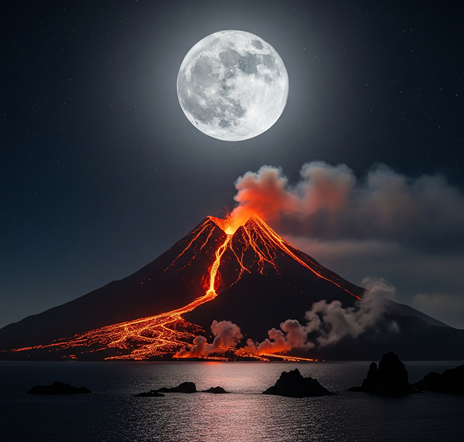
432 AND ABOVE EME NEWS
August 2025
Volume 54 Number 8
Editor: Peter Blair G3LTF
Production Assistance: Frank NC1I & Bob W1QA
NEWS CONTESTS and DXpeditions
G3LTF Editor
The main activity this month has been the first leg of the ARRL International EME contest covering the bands from 2.3GHz up. Alex, EA8DBM, also sprung a new dx-pedition on us just after the July issue went to press, covering OH0, YL and LY.
In the ARRL microwave contest most activity was again on 3 cm where, from reports received, OK1DFC leads with 39 QSOs followed by F2CT with 38 (grid multipliers of course will determine the actual score). The next highest activity was on 13 cm where OK1KIR scored 19 followed by OK1DFC with 17. Activity on 6 cm was really low, OK1DFC worked 9 followed by G4CCH and PA0PLY with 8 each. I don’t believe there was any contest activity on 9cm.
Several reports comment on the low level of North American activity, some of this was undoubtedly due to the non-eme microwave contest there being scheduled for the same weekend. A lot of regulars were missing and the activity on 6 and 13 cm is way below what it was 5 or 10 years ago. I suspect some of that drop must be due to the continuing rise of WiFi QRM. See OK1KIRs report on their latest work to counter this problem on 13 cm.
Alex, EA8DBM’s latest journey has seen more success for him on 13 cm than previously, resulting in a lot of firsts and of course he has been very busy on 23 cm as well, I hope we shall have a full report next month.
The ARRL has now responded to the threat to our EME operations on 70 cm from the AST & Science LLC (AST SpaceMobile) satellites - see :
https://www.fcc.gov/ecfs/search/search-filings/filing/108061361711890
Contests
The next leg of the ARRL microwave contest (2.3 GHz and above) is on September 13th/14th. http://www.arrl.org/eme-contest
The ARI Autumn Trophy contest is on September 20th-21st https://www.ari.it/english-area/eme/7962-11th-ari-italian-eme-trophy-2025.html
Dx-peditions
Nothing is scheduled as far as we know but the advice is the same as last month… keep an eye on Moon-net.
Corrections
My apologies to RX3DR, his entry in the SSB Funtest list last month was listed as RX3DS.
OE3JPC’s 23 cm WAC with his 2 yagi station was apparently not the first. Tom, BV3CE emailed to say that he completed the 1296 MHz WAC in 2019 with 4x30 element yagis. (Congratulations Tom, Ed)
2026 Tenerife EME Conference
Rainer EA8DMF is looking for proposals for the next EME conference. You can reach him via email at
DC1RDB Robert
Frequent thunderstorms throughout the last weeks reduced my air time considerably. Initial on 70 cm since last report: NY1V
At a field day of the local club station DL0IN end of July, I set up a small portable 432 MHz EME station consisting of my barefoot IC-910 and an 8 element YU1CF yagi on a little 3D printed rotator. The station was powered by a 120 Ah LiFePo battery. Two QSOs with NC1I were completed and OK1VUM was successfully decoded (thanks Frank and Mila for providing signals!).
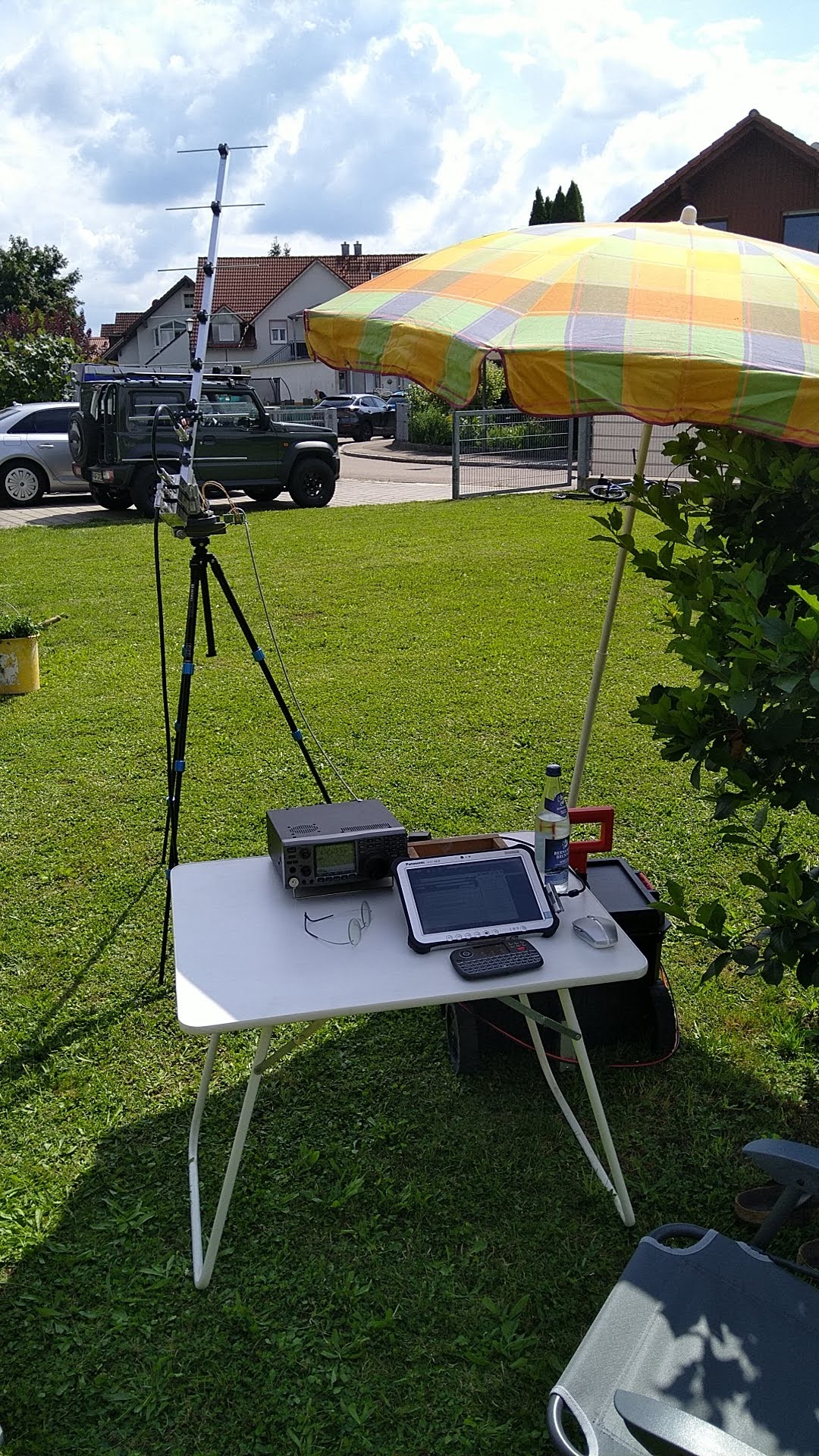 DC1RDB portable 70 cm at DL0IN
DC1RDB portable 70 cm at DL0IN
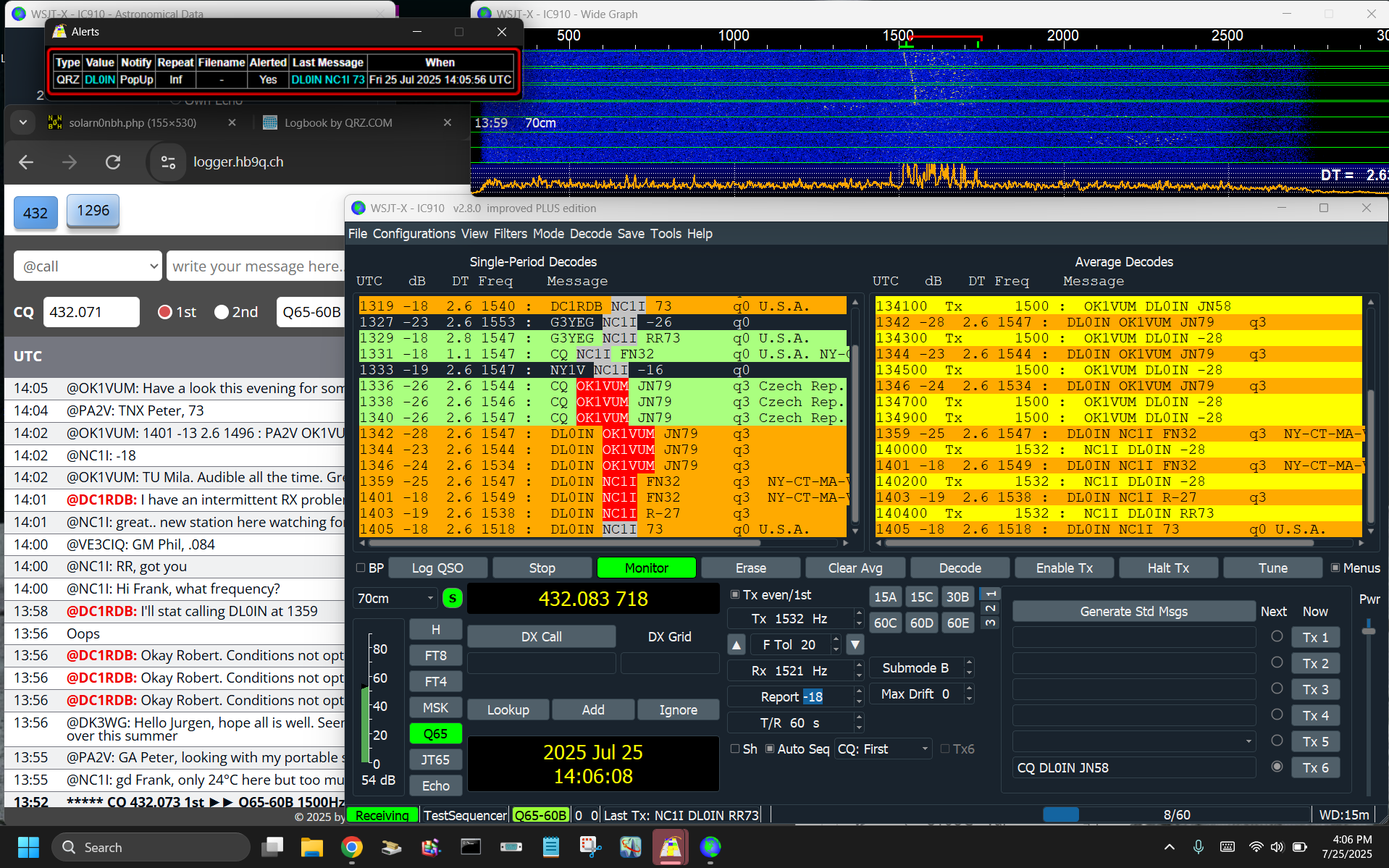 DC1RDB Screenshot 2025-07-25
DC1RDB Screenshot 2025-07-25
DJ3JJ Andreas
I have been busy making a number of improvements to my system:
1. Repositioning of the RA3AQ feed
2. Recalibration of Azimuth and Elevation Offset of the Controller
3. Rework of my LNA plus the LNA and Relay box
4. New very short Elbow Element in front of the LNA
Now i can see 11.5 dB sunnoise @ SFU 88 at 1296 MHZ (see pictures). This is a 0.5 dB improvement. Sunnoise measurement was done with SDR-Console Software in Continuum Mode with AGC off and 96 kHz Span. Normally I use SDR-Console for QO100.
I have some further improvements in the pipeline that hopefully will be implemented in September/October
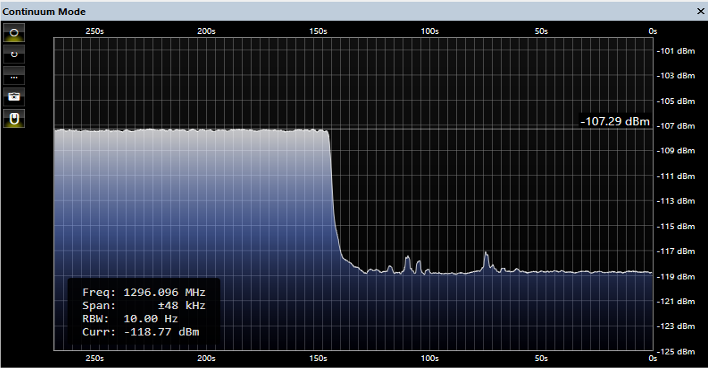 DJ3JJ sunnoise 11.5 dB SFI 88 1296 MHz
DJ3JJ sunnoise 11.5 dB SFI 88 1296 MHz
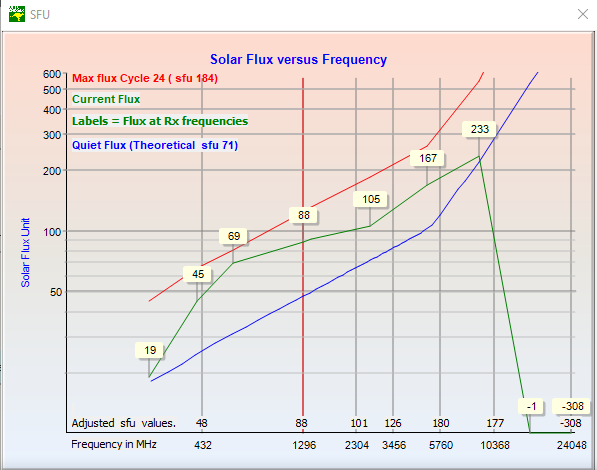 DJ3JJ SFI 2025-08-20
DJ3JJ SFI 2025-08-20
DK3WG Jurg
Worked these new ones end of July and August:
70 cm Q65-B - OM3TRN, N8LRG, G4BWP
23 cm CW - ZS6CCY
23 cm Q65-C - OZ3Z, PA2GWA, OH0/EA8DBM (DXCC#107), DL8JJ
F2CT Guy
Here is my activity report during this first leg of the ARRL EME 2025. I was only active on 10 GHz with 50 W at feed of my 4 m Cassegrain dish. High activity on Saturday morning on 10 GHz and lower on Sunday!
38 random QSOs on 10368.093 MHz with the help from HB9Q for CQ QRG. Only 1 QSO in CW all others in Q65D60.
9 new ones with 2 using 10 W into 1 m offset. 1 new DXCC with SV3AAF.
Countries worked :
- CX : 1 (CX2SC)
- DL : 2 (DJ7FJ DL4DTU)
- F : 1 (F5JWF)
- G : 4 (G4BAO G4YTL G4HSK G8RWG)
- I : 5 (IW2BNA IW2FZR I6YPK IK6CAK IK0HWJ)
- JA : 1 (JA1WQF) 10450 / 10368 MHz
- K : 3 (KM0T KN0WS N1AV)
- LA : 1 (LA4ANA) not complete!
- LZ : 1 (LZ4OC)
- OH : 1 (OH3LWP)
- OK : 2 (OK1DFC OK2AQ)
- OM : 1 (OM4XA)
- ON : 2 (ON4CDU ON5TA)
- OZ : 2 (OZ1FF OZ1LPR)
- PA : 1 (PE9GHZ)
- SM : 1 (SA5IKN)
- SP : 2 (SQ9ATC SO5AZ)
- SV : 1 (SV3AAF) new DXCC
- VE : 1 (VE6TA)
- W : 2 (W3SZ WA3GFZ)
- YO : 2 (YO2ALM YO8RHI)
No Russian and only a few US despite ARRL organisation!
Only 1 Canadian with VE6TA, nice activity from Italy and UK ,sadly nobody from Africa and no WAC!
Many of the usual calls were missing.
I hope to be on for the second party on September 13/14th probably on 10 GHz and perhaps also on 5.7 GHz.
DL3WDG Charlie
DL3WDG and DL4KGC attended our local club's Field Day and were QRV on 10 GHz EME from the portable site (JN68IK). Operating as DL0ROI we made 13 QSOs (including 3 dupes). We didn't announce our activity beforehand, as the weather forecast was very poor and operation could not be guaranteed. In the event we only had a few periods of light rain and fortunately the predicted heavy thunderstorms did not materialise.
Equipment used was a 75 cm prime focus dish, SM6FHZ 0.62 WL feed, 50 W GaN SSPA mounted at the feed and an F1OPA preamp. Sun noise was 6.5 dB and moon noise easily detectable at about 0.15 dB.
Stations worked were on the 25th PA3DZL, PE9GHZ, G4YTL, PA0PLY, IK6CAK, ON5TA, EA1IW and on the 26th PE9GHZ, ON5TA, G4YTL, IW2FZR, OZ1LPR and KM0T. We also had reception reports from W3SZ, LZ4OC, PE1MMP and one other station.
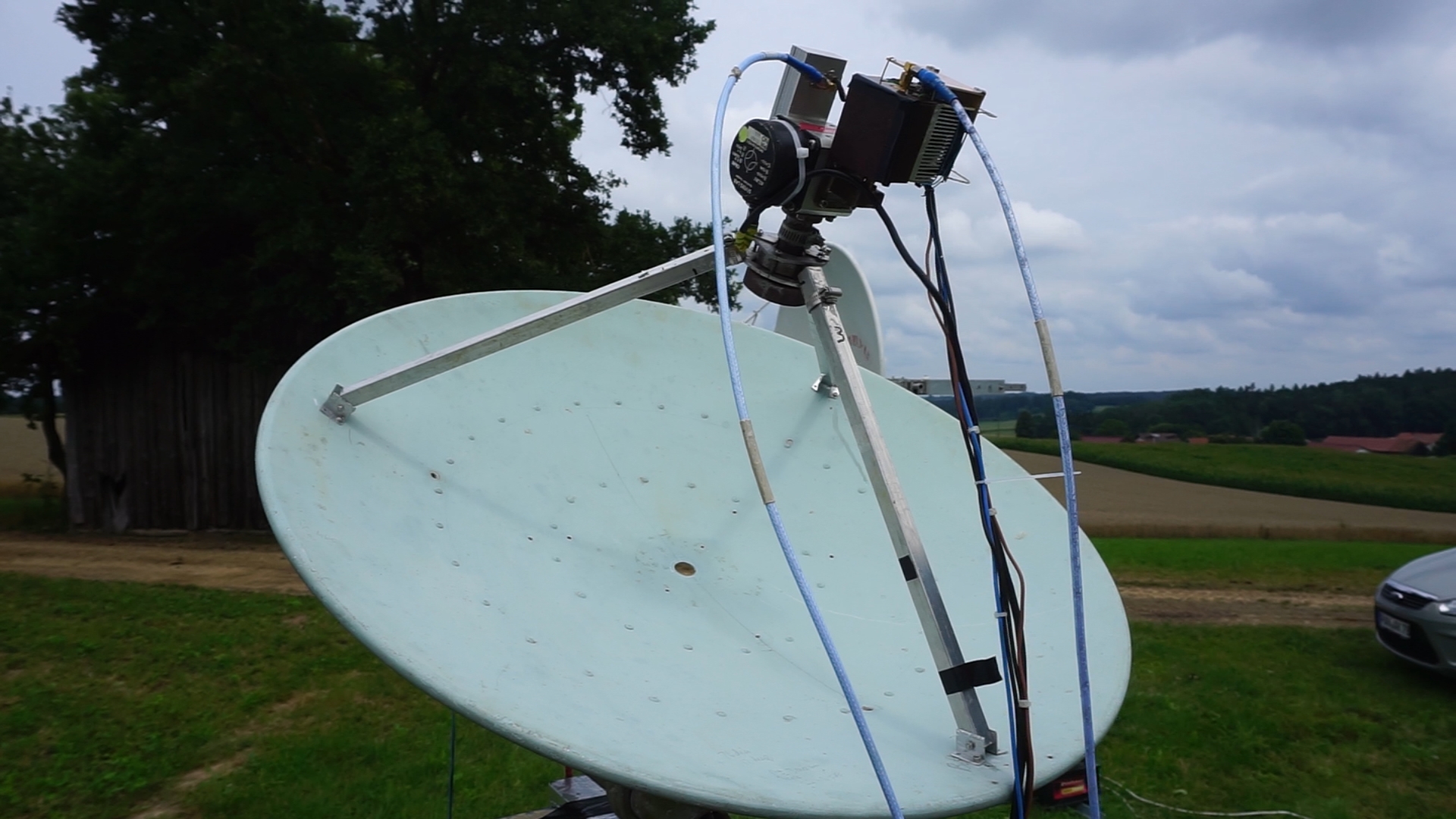 DL3WDG DL0ROI portable dish (DF8GU photo)
DL3WDG DL0ROI portable dish (DF8GU photo)
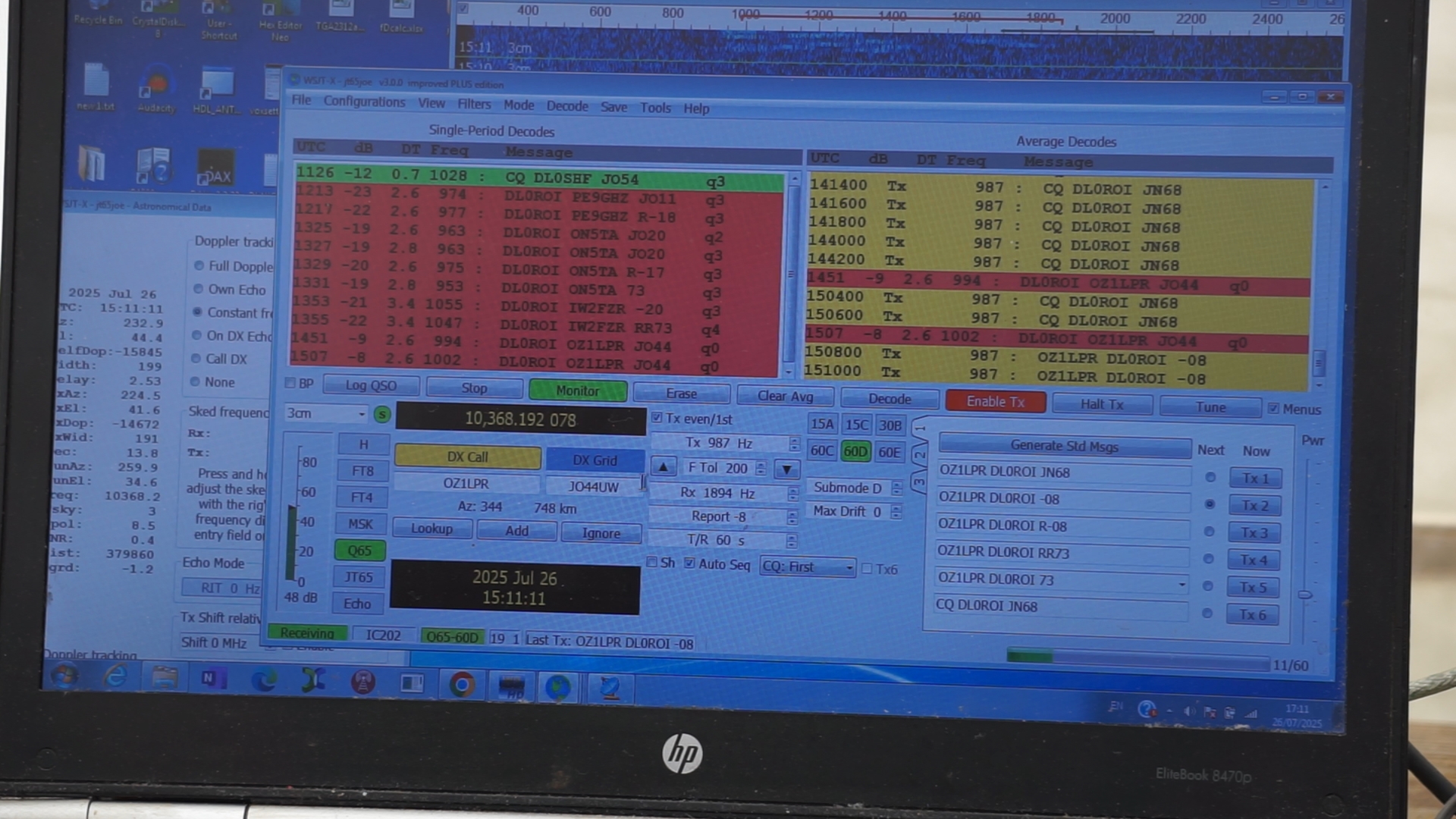 DL3WDG DL0ROI WSJT
DL3WDG DL0ROI WSJT
G0JDL John
The summer months have been considerably quieter for me on 70 cms with just two initials, PC0A and SP2WRH, in the last couple of months. These were initials 43 and 44 for me. Activity levels on the band have been quite low compared to my first six months or so on the band but its the last few weeks a few new or returning stations have become active on HB9Q that I should be able to work, given the right conditions. I have definitely noticed an increase in band noise, often 2 or 3 dB and I suspect my antenna system is picking up some sun noise from a sidelobe though I haven’t investigated this yet so I can’t confirm that this is definitely happening.
In addition to the new initials I have had QSOs with DL1VPL, ON7EQ, UA3PTW, DF3RU, OK1VUM, SM4GGC, G4YTL, DK3WG, PA2V, NC1I and OZ9AAR since my last Newsletter contribution in June.
In July I managed to blow up my SP70 pre-amp. I’m not sure if this was related to the extensive echo testing I did the previous day (I did at least manage to see some echoes) or if it was just coincidence but it was an expensive mistake to make! I’ve bought another one and will get the damaged one repaired so I always have a spare at hand, just in case I manage to do it again. I’ve also added a bit more TX delay, just to be safe.
G3LTF Peter
On 26th July I was active on 23 cm CW for the RU contest working UA3PTW, OK2PE, UA9FAD, PA3DZL, ZS4TX, N5TM, DF3RU and on 27th, RW6HM and IK1FJI.
On 16th August I put the 13 cm system in for the ARRL microwave contest 1st leg (see picture) I couldn’t face getting up at 01:00 but I did get on for 04:30 and worked on CW OK1KIR, OK1DFC, OE9ERC, OH1LRY, G4CCH, SV3AAF, SP9VFD, G4RGK and DF3RU. I kept looking on 2304 but found no US CW activity. (I discovered later that I missed WA6PY while having breakfast!)
On 17th I put the 6 cm system in and starting at about 05:30 I worked G4CCH, OK1DFC, SV3AAF, SP6GWN and DL4DTU. As activity on 6 cm was so low I put the 13 cm feed back and worked PA0PLY, OH3LWP and PA3DZL. There were a couple of weak digi stations on 2304 MHz but not equipped for CW. The overall activity on 13 and 6 cm was far lower than a few years ago, most activity was on 3 cm, and the Wi-Fi QRM problem is getting worse.
On August 21st on 23 cm CW I worked DJ3JJ (best signals ever from Andreas), G0LBK and N5TM.
Sun noise 13 cm 16th August SF123 19.8 dB and Moon noise 0.8 dB.
Moon noise 6 cm 17th August 1.25 dB
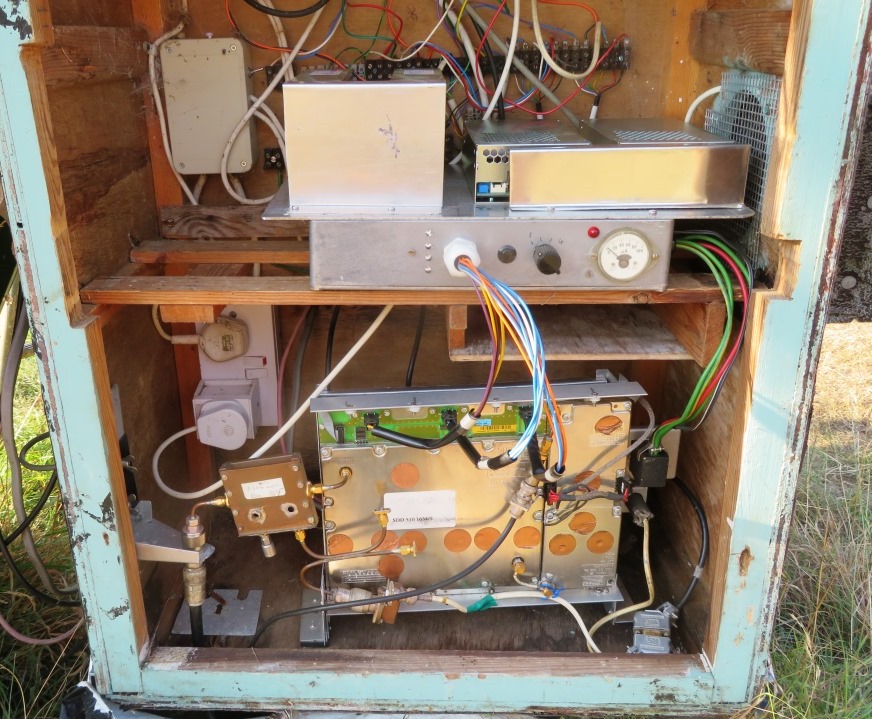 G3LTF 13 cm PA and PSU at dish
G3LTF 13 cm PA and PSU at dish
G4CCH Howard
After observing increasing loss in my RX feedline especially on 9 and 6 cm , I spent a few days on and off checking both the TX and RX feedlines. The TX feedline was OK, but found multiple RG213 jumpers in the RX feedline (after 25 years use) with stretched outer braid. Remade all the affected jumpers and checked all with my Nano VNA.
[(D) indicates digi mode QSO]
20 June 23 cm - 3A2EME (D) Init # 688
22 June 13 cm - 3A2EME (D) Init # 60
25 July 9 cm - G4IDR (D) #024, OH3LWP (D) Init # 025
26 July 6 cm - OH3LWP (D), K5DOG (D) Init #028
27 July 6 cm - WA3RGQ (D)
16 August – ARRL EME Contest Activity
13 cm - G3LTF, OK1DFC, OH1LRY, SV3AAF, SP9VFD, N1AV (D), OE9ERC (D), DF3RU, OK1KIR, OH3LWP Init #142, K5DOG (D) Init #061
17 August – ARRL EME Contest Activity
6 cm - YO8RHI (D), DJ7FJ (D) Init # 029, WA3RGQ (D), OK1DFC (D), SV3AAF, DL4DTU, DL4DTU (D), OH3LWP (D)
13 cm - OH0/EA8DBM (D) Init # 062 and DXCC, PA0PLY (D)
Poor activity in the contest especially on CW and from USA
20 August 13 cm - YL/EA8DBM (D) Initial # 063, DXCC and possible first UK to Latvia?
22 August 23 cm - ZS6CCY Initial #580, AG7CM (D) and WA4LM Init #689
Not sure which bands to be on next month in the contest – probably 13 and 9 cm
G4KLX Jonathan
During the July operating window I wasn't particularly active, not helped by heavy rain that was incompatible with the waterproofing for my EME. The plastic bag protecting my pre-amplifier isn't rated for torrential rain! Despite this I worked the following: UA4AAV (#178), W5AFY (#179), EA2BRI (#180), ZS5Y (#181), and XE1XA.
The August window was blessed with good (read dry) weather and by avoiding children's TV watching time to avoid TVI issues, I had some rather nice QSOs: KB7Q, OH0/EA8DBM (#182), PA7JB (#183), YU1DA (#184), OE5JFL (#185), KB2SA, YL/EA8DBM (#186), IZ2DJP (#187), M0FXX, NY1V, and DG0FE (#188).
There are a few things to note on these QSOs. Alex in OH0 and YL was probably the loudest that I have ever heard him, and the QSOs were easy. Very different from his DXpedition to the British Isles where I was only able to work him in GU and heard him briefly in GJ, and not at all in GD. His blog is definitely worth following to watch his progress, and frustrations. The QSO with Bill KB2SA was with him using his 1 m dish, which is remarkable, it wasn't easy but we made it. I got a reception report from Bryn GW4ZHI and I hope to work him soon.
G4RGK Dave
I operated on the first weekend of the ARRL contest on 13 cm, the stressed dish has taken a beating and the profile is not really good enough for 13 cm these days. I also have a stability problem in the mount which need some fairly radical surgery to cure. Over the years my Moon window has been seriously reduced by Conifers growing neighbouring properties.
The moon during the weekend was not favourable for Europe but did manage to drag myself out of bed at 0200 utc on Saturday the 16th Aug, the first QSO was with OK1KIR followed by OK1DFC and OE9ERC all on Q65, I then changed to CW and wkd SP9VFD and G3LTF, back on digital I put out a CQ and back came DF3RU, the band by then was very quite but after an hour I found OH1LRY on CW and worked them. That was the last QSO, as my window vanished behind the trees.
On Sunday 17th I was late getting on and had to try and work stations through the trees, but I did manage to QSO, PA3DZL, PA0PLY and OH3LWP. The 13 cm station remains the same: FT817 driving a homebuilt DB6NT transverter, DDK preamp and Ericsson PA driving a RA3AQ feed into a 4.6 m stressed reflector. Unfortunately I was unable to get the CAT function to work on the radio so I opted for traditional listening on echoes, this caused some confusion on digital but I eventually figured out where to put the TX. I will leave the feed in until the next ARRL weekend, If anyone wants a qso, please email me.
G4YTL David
432 – (4 x 22 Powabeam 600 watts) – not very active. VE3CIQ for initial.
1296 – (3 m mesh dish and 160 watts)
Highlight was working Alex, OH0/EA8DBM for DXCC 100
With G0LBK helped Bryn, GW4ZHI, getting QRV. Spent a few days with him, then the next day worked him from home. Very satisfying.
10,368 – (1.8 m offset 20 watts)
On the Saturday of the ARRL contest got up early, switched on, and no elevation tracking! After 4 hours found the fault – one of the 8 wires in the 40 m LAN cable from shack to dish had broken! The cable was a “standard” LAN and in the sun the plastic sheath had become very brittle. With the added effect of movement in the wind it had cracked in several places. Temporary fix by cutting cable and using connector block to join the eight wires. Missed all of Saturday, but got on again on Sunday for about 5 hours and worked 20 stations on Q65. F5JWF and KN0WS as initials. Following day ran a new outdoor LAN cable!
On July 23rd worked Charlie, DL3WDG, with his 75 cm dish. I have several times worked SA5IKN with his 90 cm dish. So just shows what can be achieved with well-engineered small systems.
G8RWG Neils
The week before the 1st leg of the ARRL contest I made some small changes to the 10 GHz system. I added a 3-way divider to the 432 MHz IF receive line so that I can use my analog moon noise meter and RSP1A SDR, SDR Console, QMap setup alongside the IC-705. I also wired up two 'nudge' switches to the KN3G controller so that I can peak the dish on moon noise. I typically see 0.4 - 0.7 dB of moon noise with the 1.2 m offset dish.
During the ARRL contest I completed 15 QSOs, including 6 initials. I was very pleased to work ON4CDU, my first 1.2 m dish QSO. I copied many other stations and spent a lot of time calling KM0T and YO2LAM but no luck. My QTH has a lot of tall trees and I have limited moon visibility, especially to the west. I just missed out on completing with OK2AQ when the moon was at 250 deg. Next time round I plan to move the dish to the front garden where I have a bit more visibility in that direction.
16 Aug 2025: OZ1FF -13/-19, F2CT -15/-15, OK1DFC -12/-19, ON5TA -13/-19, OZ1LPR -3/-19, DL4DTU -11/-15, OH3LWP -11/-19, ON4CDU -18/-22
17 Aug 2025: IK6CAK -13/-20, IW2FZR -15/-22, F5JWF -11/-15, G4YTL -17/-20, W3SZ -17/-20, N1AV -16/-26, HB9Q -12/-19.
Equipment: 1.2 m offset dish, 10 W, DU3T LNA – full details on https://g8rwg.uk
GW4ZHI Bryn
I’m pleased to say that the disk erection team of myself, David G4YTL, Dave G0LBK and Allan, GW4VPX, successfully erected the 2.4 m dish. (RF HAMDESIGN 0.45f/D) I was on the air in the afternoon, albeit with some teething problems due to a sticking SMA relay, and the first QSO on 23 cms was with Anders, SM5DGX. Everyone was unbelievably excited to the extent that Allan, who is a mean guitarist, regaled us with song. I’m really grateful to all the team in helping to get me on the air. Some photos are attached. In the group photo, left to right is Dave, G0LBK, David, G4YTL, myself, and Allan, GW4VPX.
Looking forward to working lots of stations off the moon on 23 cms. I have 100w at the feed. (Welcome to 23 cm Bryn, not many GW’s so you’ll be busy. Ed)
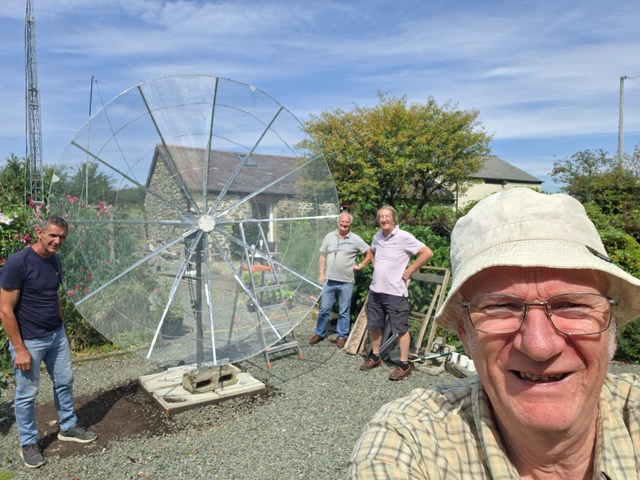 GW4ZHI antenna team G0LBK G4YTL GW4ZHI GW4VPX
GW4ZHI antenna team G0LBK G4YTL GW4ZHI GW4VPX
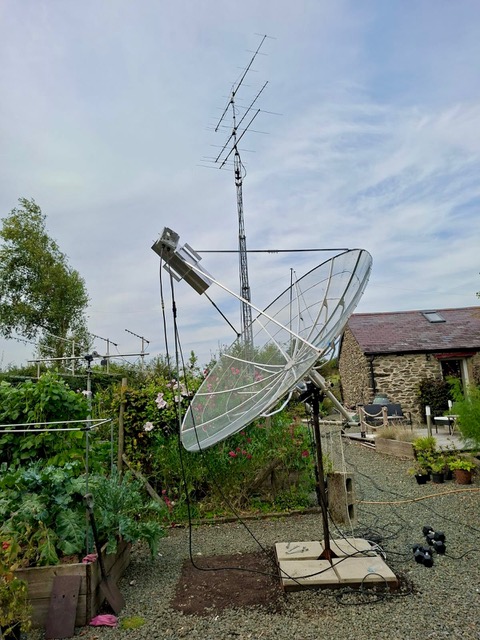 GW4ZHI 2.4 m dish
GW4ZHI 2.4 m dish
KB7Q Gene
August was an active month on 23cm for me with my 2.4 m folding dish. Conditions seemed quite good and activity was excellent. Logged: PA3EXV, PA3HDG, G4KLX, OZ5TG, DK3WG, OH0/EA8DBM #224, OK1VUM, ES3RF, W2HRO, K3SK, NoCTR, KD5CHG, NY1V #225, KB2SA and his 1 m dish, OK2AQ, W1FKF, KG0D, NC1I, KH6FA, and OZ3Z #226. I missed YL/EA8DBM by shutting down 10 minutes early.
I bought one of the 1.5 m "Solar Cooker" dishes from Amazon. $95 USD delivered to my door in three days! The dish is assembled - I'm working on the mount and feed support.
N1AV Jay
I was able to get on the first weekend of the contest with 10 GHz and 2304/2320. After a lot of thinking and planning I was able to get both 2304 TX/RX and 2320 RX / 2304 TX working on the flex 6400, that was a big win and the system worked well. Much different from all the extra gear I had to bring to Hawaii last year to make it work. We had a large monsoon storm come through about 2 days before the contest, but I assumed everything was OK based upon the visual inspection of the dish. My mistake. For the first 15 degrees of moonrise I could not hear anyone, and OK1DFC was barely in the noise at -28. Not good! Come to find out the storm had adjusted the dish about 5 degrees on EL. I corrected the aiming - and look at that! The signals came alive ;-). Stupid, stupid!
In general I know I don't hear as well as I should on 2304, but my RX was strong enough to work stations the same size as mine and larger. There is always something to improve. Activity on 2304/2320 seemed to be a bit down from last year, but there was some activity, which was great. Thank you to everyone I was able to work.
I obtained several new initials as well as those that I have contacted in past contests. I was able to snag 14 QSOs x 11 grids for the first weekend on 13 cm.
On 10 GHz, activity was good. My system is much improved from the absolute kludge that I had last year for the first (and second) weekend. Last year I probably walked over 3 miles during the contest with all of the trips out to the dish and back, and ended up sitting out there to work the 5 Q's I made. Memorable, but I didn't want to do that again. So, I revamped the system to N1AV 10 GHz V2.0. This one plays much better. On the first pass of the weekend signals appeared to be slightly down, and I was not able to work the folks with 1 m or smaller dishes that were on.
After the pass was over, and I was able to watch Wrexham play, I went back out to the shack recalibrated for sun noise and discovered that the monsoon storm had adjusted the dish about 1 degree. Upon peaking sun noise, Saturday's pass was much better, and I was able to clean up almost all of the stations that I missed on the first pass. Big thanks to many of them for getting back on the second pass.
All the Kuhne gear played well and N8CQ's Wintrack was very stable with the slew drive. I also worked several new initials on 10 GHz and ended with 34 QSOs x 31 grids for the first weekend. (MUCH improved from last year!)
Over the next few weeks I am trying to make some shack improvements and trying to improve RX on 13 cm before September weekend. I am also looking to add CW ability on both bands to try to pick up some of the stations in that mode next weekend. (I run the flex 1500 as the IF on both bands and using CW has always been an issue for me with this radio). Please be patient.
I am looking forward to picking up many more of you next month, and I will make my contest activity plea again. EU stations - PLEASE STAY ON LONGER for each pass. There is workable EME activity out here in the western part of America that is eager, willing, and able to work you! I saw on the loggers about 6 stations (on both 2304 and 10 GHz) drop off just as I was getting workable moon (all I need is 6 degrees!). I always prioritize EU over USA contacts as I know you are losing the moon.
NN3Y Nick
After my successful 3 cm EME QSO with JA stations, I was asked to spread the word that JA stations would like to have more US station active on 10450. I had relatively simple option to manipulate my KUHNE 10G5 version transverter to quickly switch between 10450 and 10380. I'm willing to share the experience with anybody having such transverter.
As we are in the middle of the Atlantic hurricane and rain season there was not much activity in my QTH. That being said, I'm just about to take down my 4X19 LFA 70 cm array along with my 1.2 m dish for 3 cm. In the meantime I'm preparing a 3 m C/KU dish with options to add 1296, 2304 and 70 cm on the dish. That would vacate my tower to get back on HF and 6 m operation that I had abandoned for the last few years. If all goes as planned, I should be QRV on 432, 1296 and 10 GHz, followed by early spring on 2304. Looking forward to log new stations.
OH3LWP Ari
Nice activity especially on 3 cm and on 13 cm during ARRL EME contest 2.3 GHz and up on August 16-17 and worked the following:
10 GHz:
16/8/2025 OZ1FF, SQ9ATC, OZ1LPR, YO8RHI, SA5IKN, G8RWG, N1AV, ON4CDU, YO2LAM, OK1DFC, ON5TA, KM0T, SV3AAF, SO5AZ, G4HSK, PE1MMP, F2CT all digital
17/8/2025 F5JWF, WA3GFZ, W3SZ, IW2FZR, DJ7FJ, LZ4OC, G4YTL, PE9GHZ, HB9Q, OM4XA, W3SZ, KN0WS, OH1LRY, G4BAO, OK2AQ, VE6TA, CX2SC all digital
5 GHz:
16/8/2025 WA3RGQ, DJ7FJ, PA0PLY, CX2SC all digital
17/8/2025 G4CCH digital
2.3 GHz:
16/8/2025 OE9ERC digital, OK1KIR digital, N1AV digital, DF3RU CW, SP9VFD CW, OH1LRY CW, G4CCH CW
17/8/2025 DL4DTU digital, PA0PLY digital, PA3DZL digital, G4RGK digital, WA3RGQ digital, G3LTF CW, HB9Q digital, OH0/EA8DBM digital
Outside the ARRL EME contest, highlights were expeditions to OH0/YL
On 1.3 GHz completed digital QSOs:
15/8/2025 OH0/EA8DBM
20/8/2025 YL/EA8DBM
On 2.3 GHz completed digital QSO:
20/8/2025 YL/EA8DBM
OK1DFC Zdenek
For the first round of the EME ARRL MW contest, I completely rebuild the control system for the upper band dish. I chose a strategy of simultaneous operation on both antennas (8 and 2.4 m offset) and made some minor adjustments to the PC equipment in my workstation.
First, the antenna controls the upper bands from 3.4 GHz. I finally got around to installing 18-bit sensors for AZ and EL in the dish, which allowed me to use the excellent EA3HMJ control system. The advantage is that the antenna position can be read to 0.001°, which has resulted in precise antenna positioning and also means that the moon noise level does not change during operation and remains constant.
In the 10 GHz band, I measured the noise of the Sun 15.8 dB and the Moon 1.8 dB before the start of the contest. These values indicate that everything should be fine. I installed a 13 cm band on the large antenna and measured the noise of the Sun 19.8 dB. So everything was as it should be here as well. The only problem was the incredible heat that prevailed on Saturday
On Friday, when I tested everything, the temperature at the 3 cm TRV in the focus of the dish was 36°C and the SSPA temperature in the dish for 13 cm was 34°C. This time, the moon windows were at night, so the merciful coolness allowed me to work at full power on all bands without overheating the equipment.
For this year's first round, I chose the 13, 6, and 3 cm bands. The most activity was in the 3 cm band. There were only 9 connections in the 6 cm band and very low activity in the 13 cm band. It seemed to me that during the second orbit, the activity was even lower.
Unfortunately, there was no one from VK on any of the bands, only Mitsuo JA1WQF on 3 cm from JA and Toshio JA6AHB on 6 cm. No one on 13 cm. On the other hand, CX2SC appeared on 3 cm, which was a DX treat. I was also waiting to see if Alex EA8DBM from OH0 would appear on 13 cm. He did, and it was my #100 digi initial on 13 cm and a new country DXCC #61. Conditions were very good, but apparently the holiday season and the intense heat reduced the number of stations active on the band. I didn't work or hear a number of familiar stations. Maybe next time, which will be on the second weekend in September. So, a total of 65 QSOs on 3 bands. We'll see how it goes next month.
After the contest I have a new DXCC YL/EA8DBM. Alex was my #101JT and #62 DXCC.
I am continuously working on 47 GHz setup. I have finally installed SSPA with water cooling SSPA which is 45 W RF. I received new SAGE WR22 switch and completed setup for first EME QSO test. More detail after successful QSO.
I am expecting to participate in 2nd leg as well. Looking forward to working those which I did not catch in August window. List of QSOs on the end.
*indicates CW
13 cm OK1KIR, BA7NQ, OE9ERC, SP9VFD*, G4RGK, DL4DTU, IK3COJ, G3LTF*, OH1LRY*, SV3AAF*, G4CCH*, DL1SUZ, DF3RU, N1AV, OH2DG*, PA3DZL, OH0/EA8DBM, (17)
6 cm JA6AHB, PA0PLY, YO8RHI, DJ7FJ, G3LTF*, WA3RGQ, G4CCH*, SV3AAF, DL4DTU, (9)
3 cm OK2AQ, JA1WQF, OM4XA,PE9GHZ, OZ1LPR, UN6PD, GW3TKH, SQ9ATC, F2CT, OZ1FF, ON5TA, YO8RHI, YO2LAM, G8RWG, LZ4OC, DJ7FJ, IW2FZR, SO5AZ, SA5IKN, WA3GFZ, ON4CDU, W3SZ, N1AV, F5JWF, N2END, SV3AAF, KN0WS, KM0T, K5DOG, OH3LWP, I6CAK, G4HSK, HB9Q, VE6TA, G4YTL, I6IPK, CX2SC, WA6PY*, G4BAO (39)
OK1KIR Vlada
Our participation in the first weekend of ARRL EME Contest was concentrated on 13 cm part of the planned 23/13 cm expedition of EA8DBM. WX conditions influenced Alex plans but we watched his news and were prepared all the time.
On Sun, Aug 17 we worked Alex as OH0/EA8DBM on 2320 MHz with Q65-60C at 11:55 with good signal (-17/-18) as new digi #118.
On Wed, Aug 20 in YL Alex suffered from terrible WiFi QRM on 2320 MHz and was forced to move to 2304 MHz. We worked him therefore a bit later at 05:16 YL/EA8DBM (-16/-17) as digi #119 and DXCC #74.
WiFi interference is increasing trouble almost everywhere and probably has impact on EME activity. On our side already a few years ago we designed new home made transverter 13 cm / 2 m with four small BP filters (3+2 rejection cavities each) which are switched for each particular 13 cm sub-band independently for RX and TX. That solution was able at that time to suppress annoying WiFi interference. Interference level however increased year by year so much that this design ceased to be sufficient. Fortunately, we later acquired an old filter from mobile BS with big heavy cavities of high quality and we succeeded modifying it to cover 13 cm sub-bands (to get a sense of its “sharpness” see the picture). This very sharp BP filter inserted via isolator on the output of DDK VLNA helped us to sustain serious operation on 13 cm.
Regardless of that effort, the small remaining WiFi interference still degrades the overall sensitivity of our 6.1 m dish system to some 135K, i.e. to overall system NF looks as bad as about 1.6 dB!
Due to that we measured on Aug 19 afternoon SN only 17.8 dB (on SDR-14) and MN during mentioned activity days was floating around only 0.6 dB. Similarly Cygnus A showed only 0.2 dB and later on M17 Sagittarius 0.25 dB.
In ARRL contest activity was quite low and we made only 6 CW and 15 digi QSOs, two stations worked both CW & Q65, so in total 19 stns in the contest. As new initial only OH1LRY was worked with great Q65-60C signal (-1/-2) as digi #117 and with CW (579/579) as CW #202. The high declination of Moon probably suppressed appearance of VK stations, but missing JA stations was surprising as well as only a few W stations.
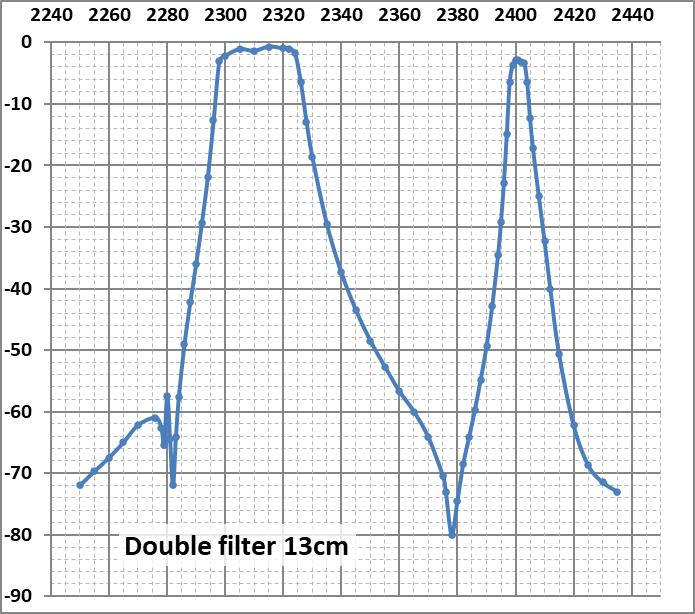 OK1KIR 13 cm filter
OK1KIR 13 cm filter
OK2AQ Mirek
EME 10 GHz June 2025
June started with excellent expedition of HB9-Q team to Sardinia. I left 3 cm in the focal point for the whole month, when the DUBUS & REF EME Contest was also held on this band. Unfortunately, I had to attend to another urgent task. So I concentrated on the new initials, which was manageable in time. In total, I managed next seven Q65 initials OK1KKD, SA5IKN, PE9GHZ, OM4XA, YO2LAM, G8RWG, KL6M and two CW OK1KKD, OE9ERC. I was especially happy with the small ones like G8RGW (1.2 m dish, 10 W), SA5IKN (0.9 m dish, 27 W) and OM4XA (2.4 m dish, 4 W). The contact with Mike KL6M {#174} 49 DXCC was a nice end to the June activity.
1296 MHz at the turn of July and August
From July 20 to mid-August, I made 50 QSOs using Q65 mode, including the following initials: N1AV, KD5CHG, LB6B, W5AFY, OZ3Z, N0LWF, DF7KB, ZS5Y, IZ5TEP, OH0/EA8DBM and EA2BRI {#227}. QSO with Alex OH0/EA8DBM (-26, -25) 52 DXCC went smoothly. Right after that, I rebuilt the setup for 3 cm.
ARRL EME Contest I. leg on 10 GHz
On Saturday, participation was very good. Unfortunately, I encountered a problem with unreliable PTT switching via CAT. This cost me several QSOs. I managed to find and fix the problem after moonset. On Sunday, at moonrise, the band was empty, so after a test connection with OK1DFC, I went to sleep, unfortunately a little longer than I wanted, and then I tried to catch up as much as I could. Overall, I made 28 QSOs (unfortunately no initial) and I am looking forward to the second leg.
On-line log: https://www.radio.feec.vutbr.cz/esl/files/EME/LOG/EME_LOG_10G.htm
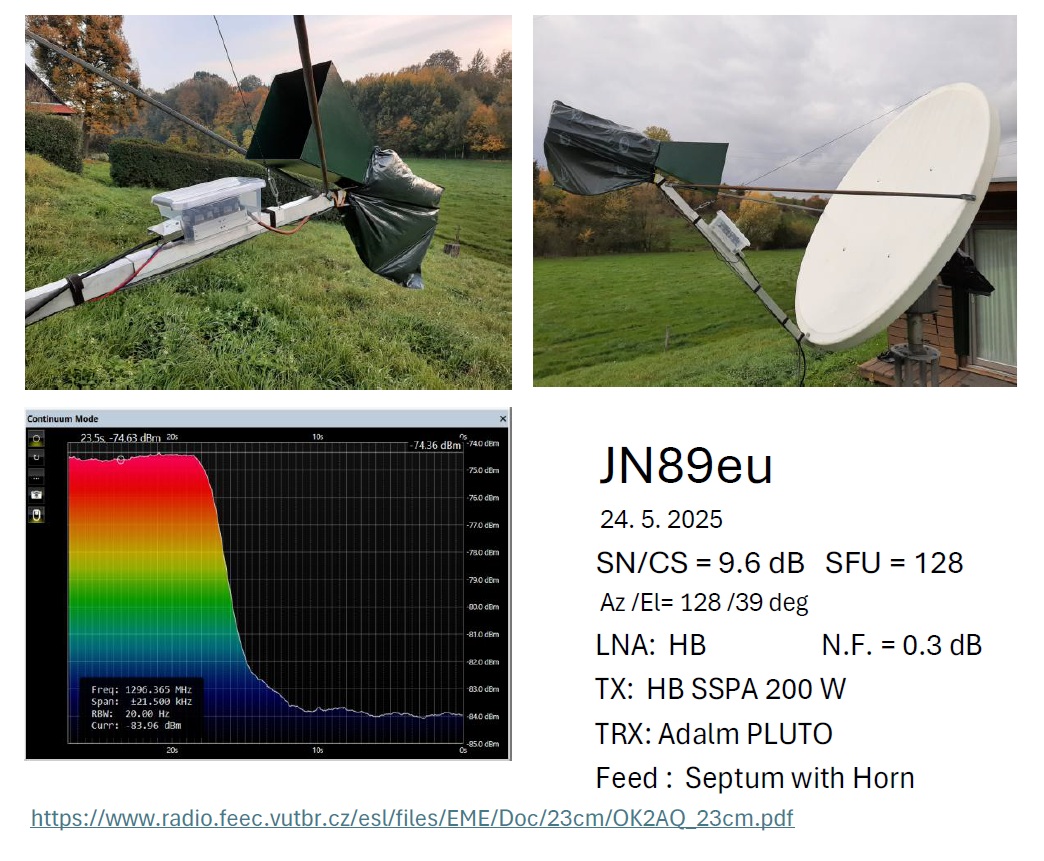 OK2AQ 23 cm sun noise to cold sky measurement
OK2AQ 23 cm sun noise to cold sky measurement
ON4CDU Hans
During the ARRL contest I worked the following stations on 10 GHz with my 120 cm offset dish and 30 Watts.
16/08/2025: YO2LAM, OZ1FF, OZ1LPR, OK1DFC, KM0T, SA5IKN (portable), DL4DTU, ON5TA, OH3LWP, LZ4OC, F5JWF, OM4XA, SO5AZ, G8RWG, N1AV, F2CT, IW2FZR, KN0WS, OK2AQ, G4BAO.
17/08/2025: W3SZ, G4YTL, HB9Q, PE9GHZ, VE6TA.
The ‘moon’ conditions on 10 GHz during the contest were quite good.
120 cm Laminas OFC 1200 offset dish, W2IMU feed, 30-watt output power. Dish on a platform with wheels and it fits in the garage. Sun noise always > 10 dB; moon noise always > 0.5 dB.
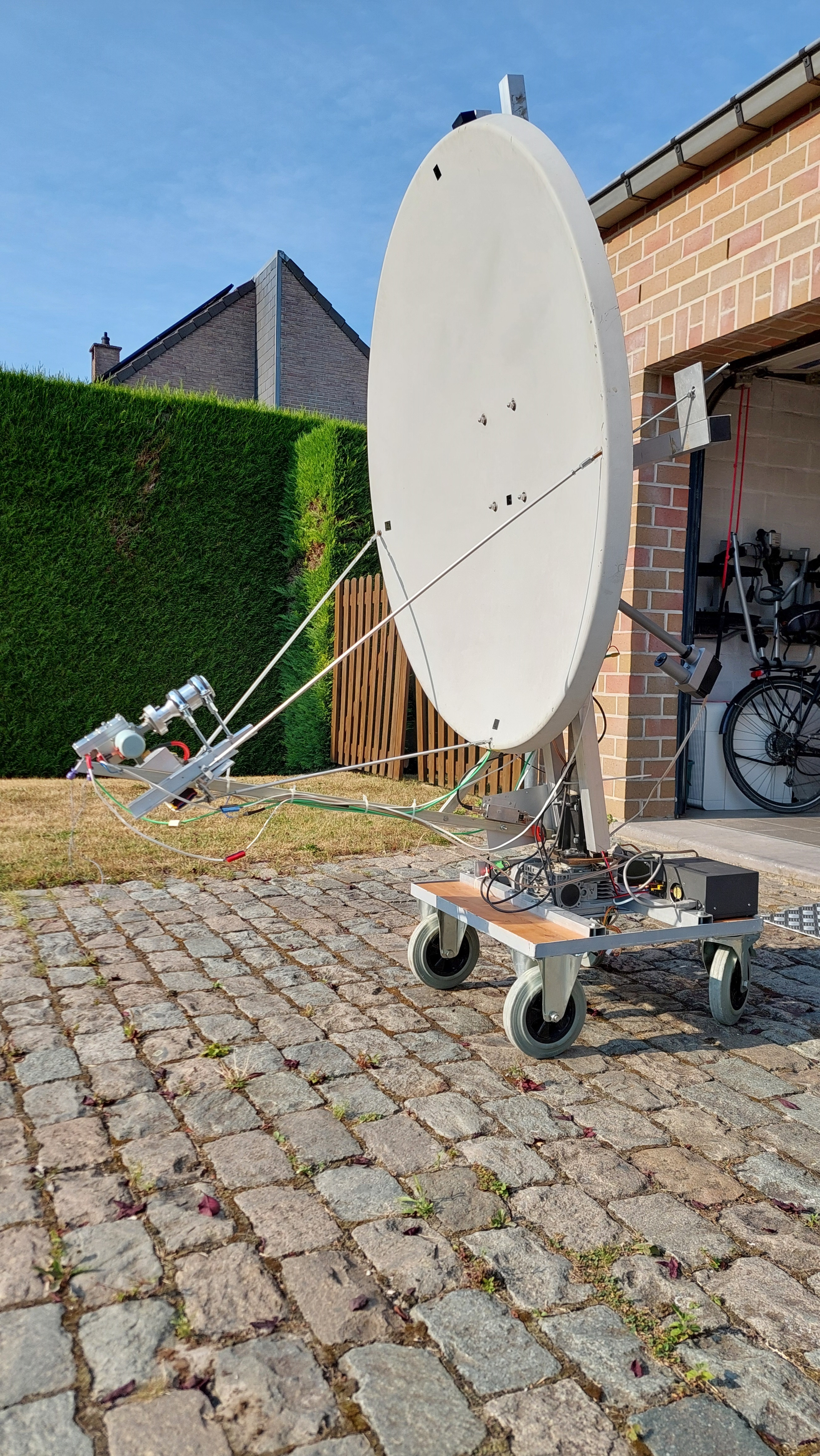 ON4CDU 1.20 m dish
ON4CDU 1.20 m dish
PA3DZL Jac
1296 MHz
Worked on 26 + 27th of July: G3LTF, OZ3Z initial #661, ES3RF, UA9FAD, PA2GWA initial #662, PHØV, JA4LJB, ZS5Y, IK1FJI, OE3JPC, GMØPJD, SP4DX initial #663, NØLWF
Worked 18th of August: OHØ/EA8DBM initial #664 and ZS6CCY initial #665 Big signals in CW!, OK1VUM and YL/EA8DBM # 666
Again a great DX-pedition from Alex EA8DBM, many thanks for your effort
2320 MHz
Worked on 17th of August: OK1KIR, N1AV X-band, G4RGK, OK1DFC, OE9ERC, SV3AAF, WA3RGQ X-band, OH3LWP, G3LTF and OHØ/EA8DBM initial #175 and DXCC #59
Worked on 20th of August: BA7NQ initial #176
Unfortunately Alex YL/EA8DBM had too much QRM on 2320 Mhz, He had a great signal but due to the QRM he had we could not make a QSO.
2300.100 and 2304.100 were ok with Alex from YL ... unfortunately not possible from PA-The Netherlands as we have permission to use 2320 - 2450 MHz only.
Thanks for great effort Alex also getting QRV on 13 cm.
3400 MHz
Worked on 25th of July: OH3LWP and G4IDR initial #89
10368 MHz
Worked on 25 + 26th of July: EA1IW, PAØPLY, G8RWG, SO5AZ initial #156, PE9GHZ initial #157, DLØROI initial #158, SA5IKN, W3SZ and G4HSK
Great to see small dish stations getting QRV on 10 GHz with nice signals. Hope more OMs will get motivated to become QRV also.
Was on holiday for a few weeks so missed activity during the first two weeks of August.
PA0PLY Jan
I decided to follow the suggestion to be QRV on 6cm on August 16th, the first moonpass of the ARRL. I was up early to catch JA, but unfortunately only JA6AHB was QRV. After a small nap I was on in the morning and worked OK1DFC, WA3RGQ , DJ7FJ, CX2SC, OH3LWP and WA6PY all on digimode.
Around lunchtime I caught Henryk SP6GWN for #58 in CW. With his 3.3 m dish and only 36 W he was really weak but consistent.
No further stations did appear on 6 cm. After changing to 13 cm I hoped on a better result the next moonpass.
On August 17th I worked on 2320 Mhz N1AV #86, OE9ERC, OK1KIR, G4RGK #87, WA3RGQ, OH3LWP, DL4DTU, G3LTF, OH0/EA8DBM #88, G4CCH.
Alex, OH0/EA8DBM had trouble to keep the dish on the moon and fight the Wifi distrubance, but we made it.
It was a bit disappointing on the amount of stations QRV on 13 cm during the ARRL contest especially the US based stations. I did copy SP9VFD many times on 2304 Mhz in CW, but he did not listen on 2320 Mhz thus we did not make the QSO.
After the contest I worked Terry BA7NQ on August 20 with good signals (-16/-19).
In the meanwhile I am working on my new band, 3400 MHz.
At PI9RD the dish is moving again after a forced stop due to oil issues.
I will test the 3400 Mhz system of PI9RD coming days with the 25 m dish. In the meantime we are working on a new small dish, 2.5 m which is nearly completed.
Regarding the DU3T 24 Ghz parts, we are well on the way with our WR42 waveguide switches and KLNA preamps. A next batch of both are now planned.
All details are on my website and the latest EME database is updated around the 15th of every month: https://www.pa0ply.nl/eme-directory/
SA5IKN Max
10 GHz EME July 2025 Report
In July, I focused on resolving the remaining teething issues with my portable 10 GHz EME system, which consists of a 0.9 m dish and a 27 W power amplifier (see photo). After some refinement, I am pleased to report that the setup is now well-suited for reliable portable deployment. Although I do not have any DXpedition plans at present, not even tentative ones, it is reassuring to know that the system is ready should the opportunity arise.
While the system remained set up on my balcony for adjustments, I popped up for a few short moonbounce sessions, working six stations, including two new initials: IK6CAK and OH3LWP. I also ran tests with Ric CX2SC and Steve G4HSK, which we plan to retry once I am fully portable again. Particularly encouraging were the signal reports from Bruno I6YPK, who uses a dish only slightly larger than mine (1 m).
Overall, my 10 GHz EME activity in July was somewhat lighter than in June, when in a single four-hour session, I worked 19 stations. That day included a memorable portable-to-portable contact with IS0/HB9COG, which was also the first SM–IS0 QSO on 10 GHz.
Overall, I am very satisfied with the performance of my portable, battery-powered system. After just 10 short EME sessions, I have now passed 30 initials.
In parallel with my operating activities, I have also been working on the software side.
Several months ago, I developed a web application to support my portable 10 GHz EME work. After extensive testing and dozens of successful QSOs, including some with spatial polarization offset tracking, I have now made the tool publicly available. I hope it may prove useful to at least a few others in the community.
EME Observer: https://dxer.site/eme-observer/
User Guide: https://dxer.site/eme-observer/user-guide.html
Key Features:
• Interactive map of known 10 GHz EME stations (active, DXpeditions, and SKs). Clicking a marker reveals station details.
• Geocentric Moon data: footprint, distance, declination, and additional path loss relative to perigee (in 30-minute intervals).
• Topocentric data for both Station Locator and DX Locator:
- Moon azimuth and elevation
- Moonrise and moonset times
- Libration rate
- Doppler spread (equivalent to Width in WSJT-X)
• One-click “Sked” planner showing common Moon windows, with:
- Combined libration rate
- Combined Doppler spread (DXWid in WSJT-X)
- Spatial polarization offset (Dpol in WSJT-X)
Also included:
• Antenna, power, and DXCC statistics
• Filterable table of active and SK 10 GHz EME stations
All calculations are accurate to better than 1 arcminute (0.017°). Although designed specifically for 10 GHz, most metrics (except Doppler spread, which is calculated for 10.368 GHz, and some libration effects) are applicable to other EME bands.
Note: This is not a link budget calculator. It assumes users can interpret the data according to their own station configuration.
Station data can be added or edited using the “Add Station” button.
I would like to thank Jan PA0PLY for testing the application and for maintaining the excellent 432 MHz and above EME station lists, which were invaluable during data validation.
Website: https://dxer.site
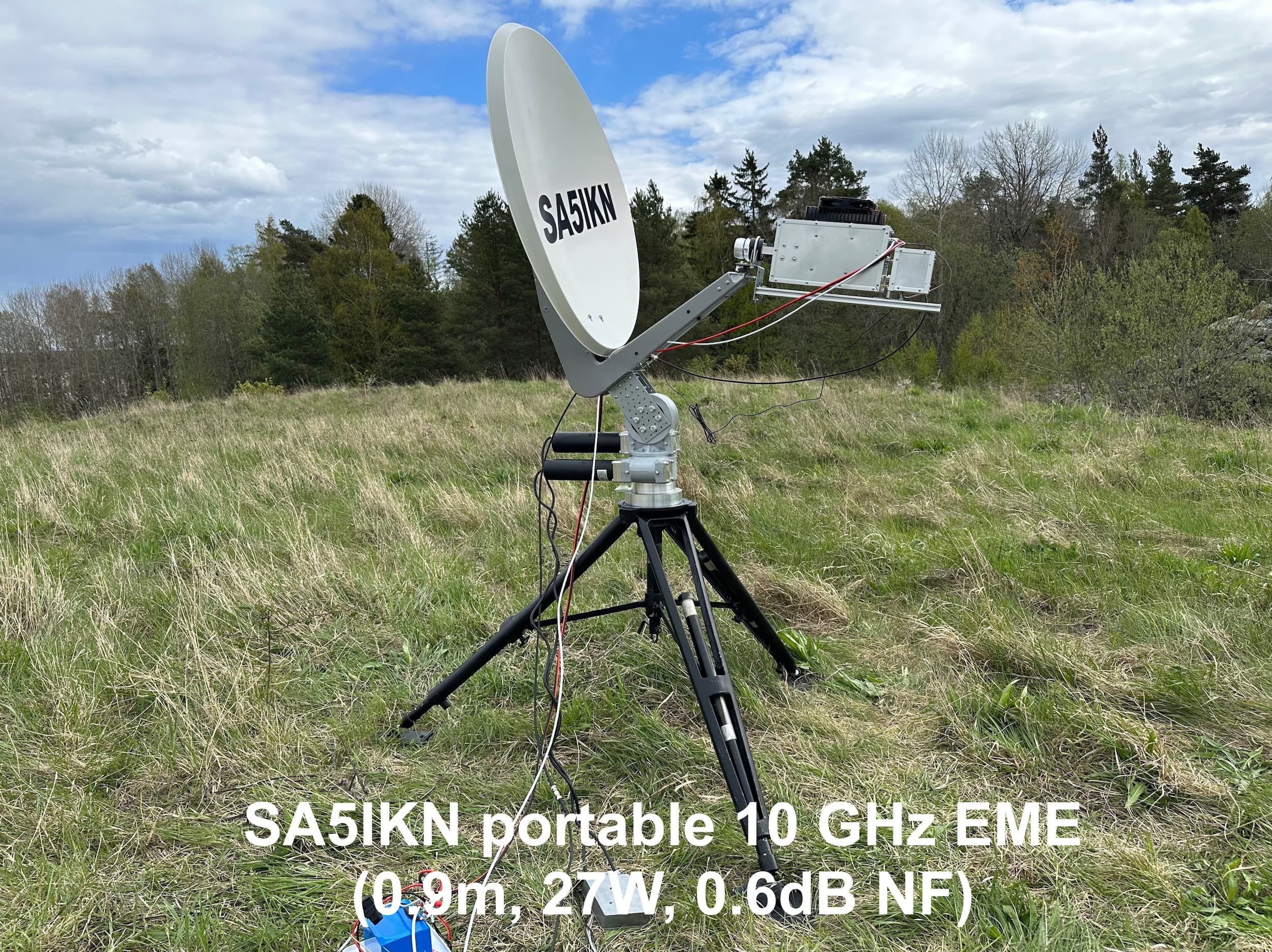 SA5IKN portable 10 GHz EME
SA5IKN portable 10 GHz EME
SM2CEW Peter
I had a visit from Michael SA6BUN (aka DL1YMK) and XYL Monika. Here we are checking out the antennas for 70 & 23 cm, and 3 cm.
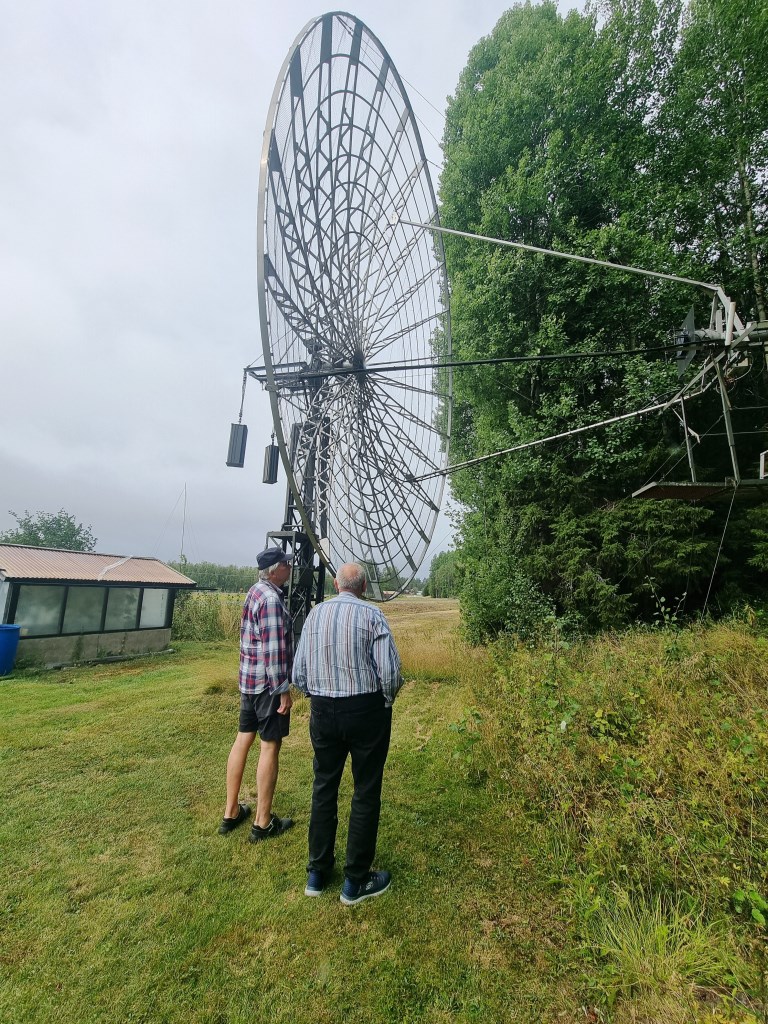 SM2CEW 70 cm and 23 cm dish
SM2CEW 70 cm and 23 cm dish
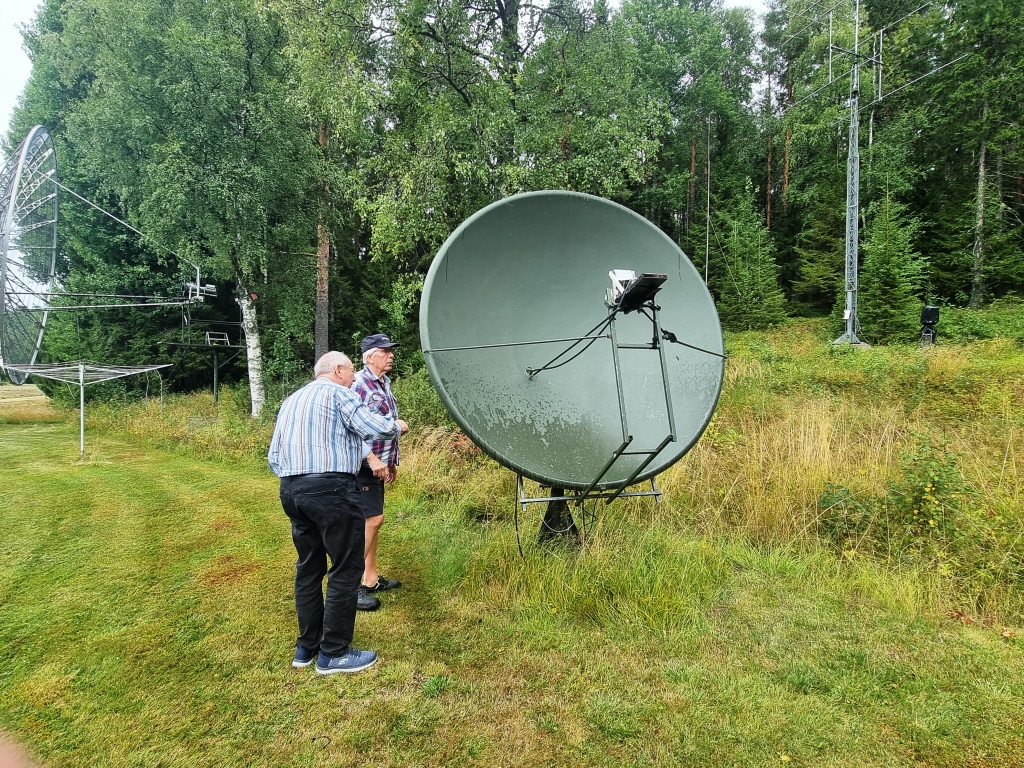 SM2CEW 3 cm dish
SM2CEW 3 cm dish
SP9VFD Raf
I operated on 13 cm EME for Saturday and Sunday during ARRL EME 1st leg. Seems that conditions were pretty good, I heard my own echo very loud all the time despite that I was running only 150 W at the feed. I had worked random CW only, with following stations: DF3RU, DL1SUZ, G3LTF, G4CCH, G4RGK, OH1LRY, OH3LWP, OK1DFC, OK1KIR, SV3AAF, WA6PY
I hadn't heard from anyone more but it’s possible that I missed someone because I didn’t stay in the shack all the time.
Measured SUN/CS(Leo) = 20,5 dB, at SFU 10,7 cm = 105 on Saturday August 16th.
My current 13 cm setup includes: 640 cm dish, RA3AQ septum feed, 150 W SSPA, LNA WA6PY (0.3 dB NF, 36 dB gain), SM6FHZ Band Pass Filters x 2, MKU23 G4 Transverter, Icom IC-9700 (144 MHz IF), RspDuo SDR receiver (144 MHz IF), OE5JFL antenna controller with HH-12/HH-12INC. I’m finishing 2 new antenna controllers based on Gary’s N8CQ WinTrak + Raspberry Pi 5 and I will use it with encoders BRT38 15 bit RS485 for both of my dishes AZ/EL readings.
I’m going to raise 3 m solid dish before the ARRL EME 2nd leg in September. There is an opportunity that I will be active both 6 cm and 13 cm simultaneously in the September part of ARRL EME.
Many thanks to all for the nice 13 cm QSOs. I will look forward to operating EME 6 cm / 13 cm in September.
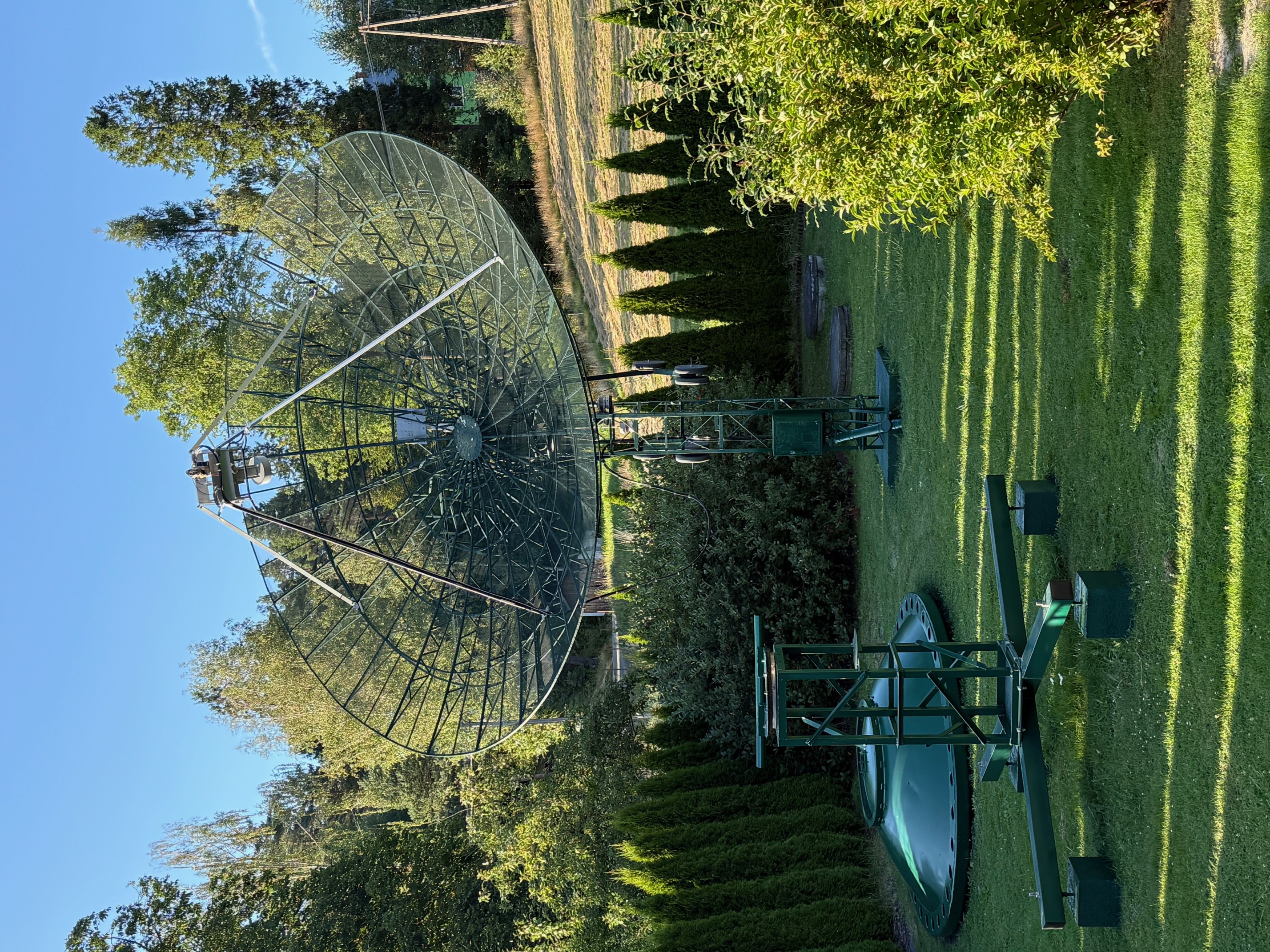 SP9VFD ARRL EME Aug 2025
SP9VFD ARRL EME Aug 2025
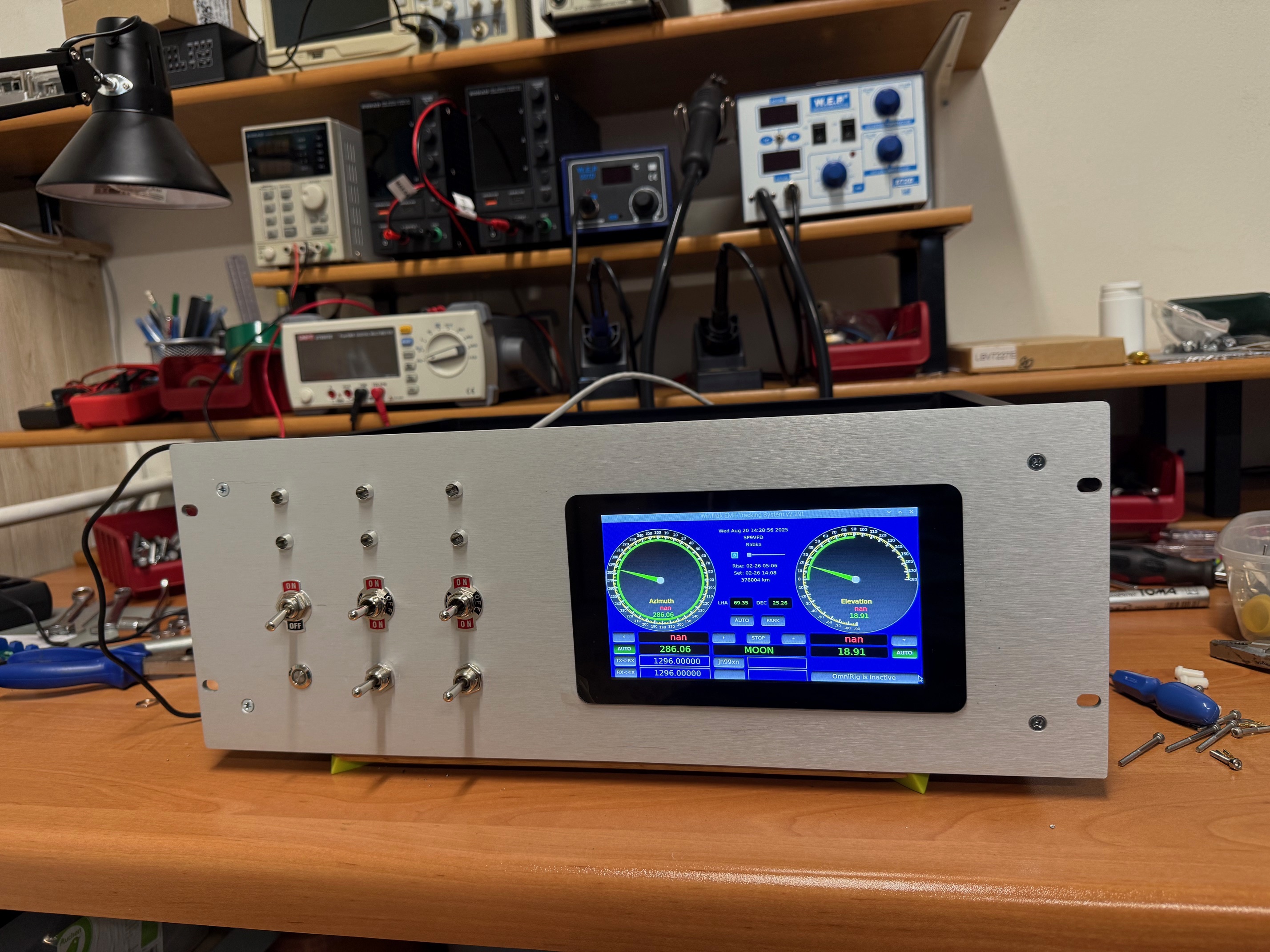 SP9VFD WinTrtak RPI5 front
SP9VFD WinTrtak RPI5 front
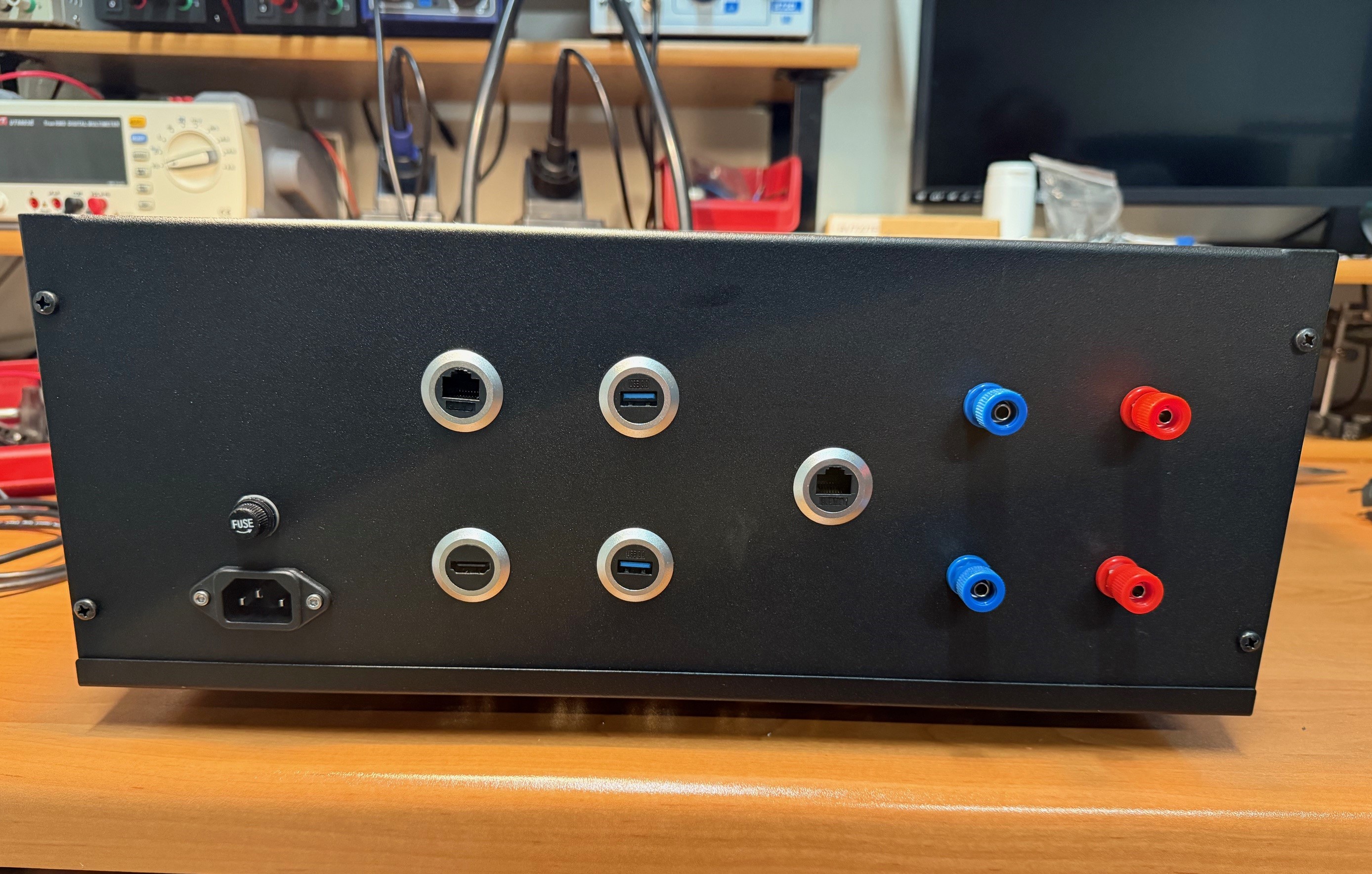 SP9VFD WinTrtak RPI5 rear
SP9VFD WinTrtak RPI5 rear
VE6TA Grant
222 MHz EME
AC0RA went on a single yagi EME dxpedition to IL and MO for states number 30 and 31. I was able to work Wyatt fairly easily in IL, but after daybreak faraday made the second state a bit more difficult. Really gave the polarity rotor a workout to work him but got it done.
10 GHz EME
August 16/17th was the ARRL microwave EME contest first leg. It was very rainy here the first pass so had to settle for 10 GHz EME on the second pass. I have to say conditions were very good with lots of activity, low spreading and low loss. Some of the smallest stations I have ever heard were workable... Amazing conditions. Stations in the log from last night were: F5JWF, OZ1FF, OZ1LPR, OK1DFC, F2CT, OK2AQ, KM0T, N1AV, #LZ4OC, #OM4XA, ON4CDU, ON5TA, #PE9GHZ, #G4BAO, #SA5IKN, OH3LWP, G4YTL. (Up to 56 initials and 25 DXCC now on 10 GHz) SA5IKN was a portable battery powered station with a 90 cm dish and 22 w twta. Extremely well optimized to work my big floppy mesh dish too.
5.5 m dish with 3 el modified quagi feed and 1 kw on 222 MHz EME.
5.5 HB mesh dish with conical feed and 30 w on 3 cm EME.
XE1XA Max
Finally I had some free time and system working FB to be able to be QRV during the past weekend RU Contest. (July 26-27th)
On 23 cm, Q65-60C and 30B, I worked: IZ2FAK, PH0V, UA3PTW, OK2AQ, OZ3Z, UA4AAV, KC2HFQ, N5TM, LB6B, GM0PJD, PA3JRK, VK4CDI, RX3DR, UA3FAD, RW6HM, G4KLX, GM0PJD, N0LWF, DJ3JJ, W5AFY, PA3EXV, W4UNU, OZ5TG and KG0D, for a total of 24 QSO, all of them with good signals at the 1st attempt, some of them looking for a new country or a new initial.
I was not working on CW since there are always less stations on such mode, very sorry.
Since I’m more an experimenter than a contest aficionado I’m not pretending its a good score, but it has been a long time since my last EME Newsletter report. (And its very welcome Max, Ed)
Stations needing Mexico for DXCC have only to send a request to my e-mail address.
Tenerife Travel Plans
Bob W1QA
When I lived in The Netherlands I always wanted to visit Ibiza and the Canary Islands and never ended up going. 2026 will change that with the EME Conference in Tenerife.
Flights
For Europeans, flights to Tenerife are plentiful and in my opinion, quite inexpensive. There are lots of options, including low cost subsidiaries of major airlines. For those of us who are outside of Europe, some investigation and creativity may be needed.
I've flown over 2.5 million miles / 4.000.000 km and I stopped counting over a decade ago. I'm always up for venturing to someplace new, and I like to make my own reservations, where I have some control over my destiny.
A good tool to research flights is: https://flights.google.com
To view pricing to cities around the globe from Tenerife:
Choose: One way
Where from? TCI (Tenerife - all airports)
Click: Explore
You'll get a nice map of cities and pricing - this can be used as a general starting point to plan your flights to the conference! As I'm writing this article it shows a flight from Edinburgh Scotland is only USD $40 / EUR €34 one-way. I'm sure there are other charges - like baggage fees (and maybe even using the WC ?!?!) - still an amazing fare for a 5 hour flight!
Click on your city and it will show routings on the left-hand side. Then click View Flights and you'll see all the options.
For example:
From San Francisco the best option is likely American (AA) from SFO to JFK, and then Iberia (IB) from JFK to MAD, connecting to Iberia Express from MAD to TFN.
From Tokyo the best option may be Qatar (QR) from Narita NRT to DOH, connecting to Iberia (IB) DOH to MAD and Iberia Express from MAD to TFN. Another option is LOT from NRT to Warsaw (WAW) to Tenerife (TFS).
Usually a round trip is priced lower than two separate one-way tickets - but - you may find that you can get better routing to the conference, and back home, with two separate itineraries. That's what we are doing.
A note about booking: Google Flights will provide you links to various places you can buy tickets, which usually includes the airline directly, as well as third party booking sites. I always book my tickets directly with an airline because if you need to make any changes or have any issues, if you booked with someone other than the airline, you will need to work with that company.
Google Flights can also monitor pricing for city pairs - it will show you whether today's price is typical, or higher or lower than normal. It can also alert you if there are price changes. (Normally the lowest cost seats sell out first and the closer you get to your date of travel the price increases.)
For us - I have been able to make a reservation from Boston on British Airways to London connecting to Tenerife. Boston is not my preferred airport - about 2 hours away and that is with no traffic. But I was able to make this routing and upgrade it to business class (using American Airlines miles / points), and those were the last two seats available to upgrade. This will be my first flight in an A380, so another thing off my bucket list. The other downside: we arrive at London Heathrow (LHR) and depart to Tenerife from Gatwick (LGW). Ask me at the conference how that transfer went! :)
If you do not have a frequent flier number for the airlines you will be flying, consider signing up - even if you don't fly often. Many airlines will let you earn miles / points in a partner's program. For example, my British Air reservations have my American Airlines frequent flier number. Check the airline's web site for partnerships, etc. For Iberia: https://www.iberia.com/us/our-alliances/
Hotel
Hotel Botánico & The Oriental Spa Garden
https://www.hotelbotanico.com/en/
(note: their website is available in ES EN DE and FR)
We are looking forward to our stay at this property. Not often that we get to stay at a 5 star hotel and our view of their web site gives us the feeling that this will be a great place to visit, relax and socialize. Rainer EA8DMF also noted that the hotel had some renovations and upgrades this spring.
The Botánico is a member of The Leading Hotels of the World. I would suggest joining this frequent guest program as it may provide you with additional benefits if you include your member number with your booking. You can create an account here: https://www.lhw.com/leaders-club-hub?hotel=6872 The program is called the Leaders Club.
Rooms for the conference need to be booked by 31 Jan 2026 using the code EME2026. Currently the hotel's web site is only taking bookings through April 2026 (I would expect on the web site May to open up next month). The hotel will take reservations now for the conference - you can contact them via phone on (+34) 922 381 400 (main number) and
Be sure to let Rainer know that you'll be attending, and whether a guest will be coming. His email is